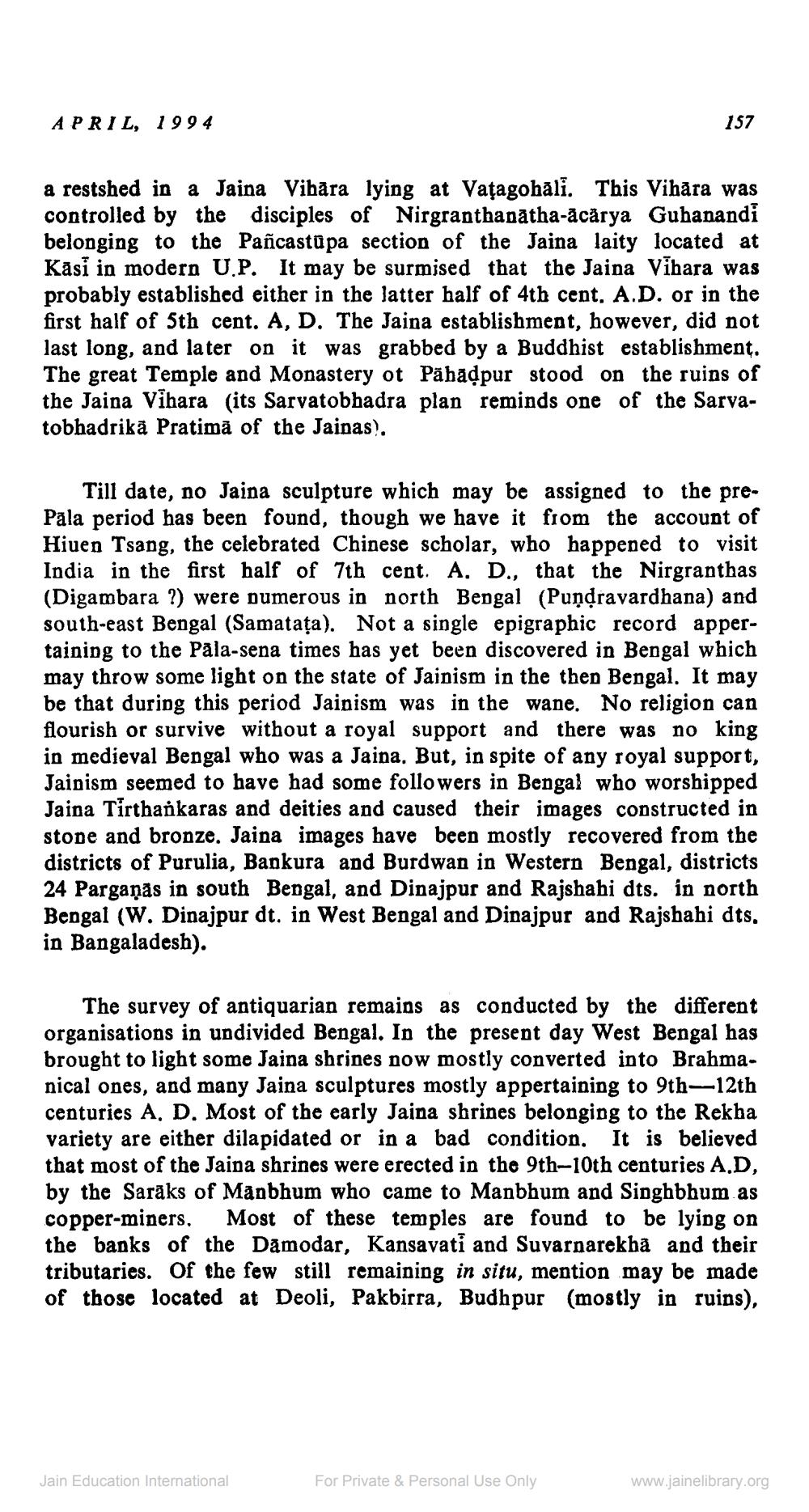Book Title: Jain Journal 1994 04 Author(s): Jain Bhawan Publication Publisher: Jain Bhawan Publication View full book textPage 6
________________ APRIL, 1994 a restshed in a Jaina Vihara lying at Vatagohali. This Vihara was controlled by the disciples of Nirgranthanatha-ācārya Guhanandi belonging to the Pañcastupa section of the Jaina laity located at Kasi in modern U.P. It may be surmised that the Jaina Vihara was probably established either in the latter half of 4th cent. A.D. or in the first half of 5th cent. A, D. The Jaina establishment, however, did not last long, and later on it was grabbed by a Buddhist establishment. The great Temple and Monastery ot Pähäḍpur stood on the ruins of the Jaina Vihara (its Sarvatobhadra plan reminds one of the Sarvatobhadrika Pratima of the Jainas). 157 Till date, no Jaina sculpture which may be assigned to the prePala period has been found, though we have it from the account of Hiuen Tsang, the celebrated Chinese scholar, who happened to visit India in the first half of 7th cent. A. D., that the Nirgranthas (Digambara ?) were numerous in north Bengal (Pundravardhana) and south-east Bengal (Samatața). Not a single epigraphic record appertaining to the Pala-sena times has yet been discovered in Bengal which may throw some light on the state of Jainism in the then Bengal. It may be that during this period Jainism was in the wane. No religion can flourish or survive without a royal support and there was no king in medieval Bengal who was a Jaina. But, in spite of any royal support, Jainism seemed to have had some followers in Bengal who worshipped Jaina Tirthankaras and deities and caused their images constructed in stone and bronze. Jaina images have been mostly recovered from the districts of Purulia, Bankura and Burdwan in Western Bengal, districts 24 Parganas in south Bengal, and Dinajpur and Rajshahi dts. in north Bengal (W. Dinajpur dt. in West Bengal and Dinajpur and Rajshahi dts. in Bangaladesh). The survey of antiquarian remains as conducted by the different organisations in undivided Bengal. In the present day West Bengal has brought to light some Jaina shrines now mostly converted into Brahmanical ones, and many Jaina sculptures mostly appertaining to 9th-12th centuries A. D. Most of the early Jaina shrines belonging to the Rekha variety are either dilapidated or in a bad condition. It is believed that most of the Jaina shrines were erected in the 9th-10th centuries A.D, by the Saraks of Manbhum who came to Manbhum and Singhbhum as copper-miners. Most of these temples are found to be lying on the banks of the Damodar, Kansavati and Suvarnarekha and their tributaries. Of the few still remaining in situ, mention may be made of those located at Deoli, Pakbirra, Budhpur (mostly in ruins), Jain Education International For Private & Personal Use Only www.jainelibrary.orgPage Navigation
1 ... 4 5 6 7 8 9 10 11 12 13 14 15 16 17 18 19 20 21 22 23 24 25 26 27 28 29 30 31 32 33 34 35 36
